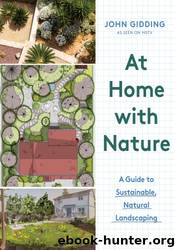At Home with Nature by John Gidding

Author:John Gidding [Gidding, John]
Language: eng
Format: epub
Published: 2023-01-15T00:00:00+00:00
Effects of Light and Shade
While turf grass and vegetables require 6 to 8 hours of direct sunlight to prosper, a naturally occurring forest glade does not. In a sylvan landscape, shade, the bane of sod, now helps keep moisture in the soil and the house cool in summer. In winter, the shade will disappear with the leaves and the added sunlight will help keep the house warm. The increased number of trees will have a kaleidoscopic effect on the influence of light and upon the landscape. Consider, for example, the effect of morning light, when the sun is in the east. Toward the west, every tree will be seen in full light without shadow; if one turns north or south, the trees will be seen in both the light and the shade; and if one looks east, toward the coming of the sun, the trees are backlit silhouettes. These light and shade interactions will slowly tint the atmosphere as day moves toward night.
2. SPECIES STRATEGIES
Trees
If a suburban yard is to harbor its own ecosystem in reasonable time, using only large trees with slow growth rates will neither provide much immediate gratification nor support wildlife. Nor will the property be able to sustain so many large trees when they mature. Including small to medium-sized trees with moderate to fast growth rates builds a more complete ecosystem that will coalesce at a faster rate. Comfort can be taken from the fact that almost all trees have the capacity to live for at least a hundred years.
As shade, the eternal enemy of turf grass, loses its sting, the number of trees that can be planted in residential neighborhoods increases dramatically. Considering their size, visual impact, and ecological importance at maturity, trees are the least expensive of plants. The groupings of trees will become the sylvan landscapeâs focal points as they mature. The practicality of such arrangements is also to be considered, for example: light-textured deciduous trees with moderate to fast growth rates, placed closer to the house, will neatly parcel out the sun and shade during summer months and not block the sunshine during winter months. Generally, the backyard will offer more latitude for planting trees than a front yard encumbered by primary paths and a sidewalk. If there are healthy, mature, non-native trees in the yard, they should not be removed, but rather incorporated in the overall design.
The total amount of trees that can be contained in a yard does not depend upon the diameters of their mature crowns, which can overlap slightly. Tree crowns can, and often do, extend beyond the propertyâs boundaries, although it is not advised that they overhang the house. Nor is the size of a treeâs crown at maturity necessarily proportional to the treeâs height, as tall trees can have small crowns and vice versa. There is also the height of the first branches above the ground to consider, as there are small trees with high crowns that can be walked under and large trees with low crowns that must be walked around or climbed into.
Download
This site does not store any files on its server. We only index and link to content provided by other sites. Please contact the content providers to delete copyright contents if any and email us, we'll remove relevant links or contents immediately.
Turbulence by E. J. Noyes(7059)
The Thirst by Nesbo Jo(5794)
Gerald's Game by Stephen King(3927)
Be in a Treehouse by Pete Nelson(3234)
Marijuana Grower's Handbook by Ed Rosenthal(3126)
The Sprouting Book by Ann Wigmore(3056)
The Red Files by Lee Winter(2923)
The Remains of the Day by Kazuo Ishiguro(2627)
Sharp Objects: A Novel by Gillian Flynn(2451)
Christian (The Protectors Book 1) by L. Ann Marie(2396)
Organic Mushroom Farming and Mycoremediation by Tradd Cotter(2314)
The Culinary Herbal by Susan Belsinger(2063)
Stone Building by Kevin Gardner(1998)
The Starter Garden Handbook by Alice Mary Alvrez(1930)
Lilac Girls by Martha Hall Kelly(1883)
The Unlikely Pilgrimage of Harold Fry by Rachel Joyce(1838)
The Lean Farm Guide to Growing Vegetables: More In-Depth Lean Techniques for Efficient Organic Production by Ben Hartman(1789)
Urban Farming by Thomas Fox(1752)
Backyard Woodland by Josh VanBrakle(1591)
